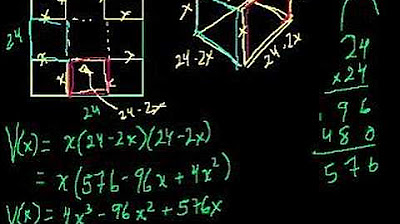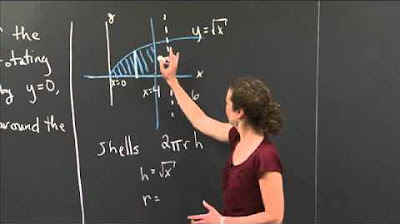Closest Point to the Origin | MIT 18.01SC Single Variable Calculus, Fall 2010
TLDRIn this instructional video, Professor Christine Breiner guides students through an optimization problem to find the point on the curve y = √(x + 4) that is closest to the origin. She emphasizes the importance of anticipating the solution's region and introduces the concept of optimizing the square of distance for simplicity. The solution involves setting up the optimization equation with the given constraint, taking the derivative, and solving for x, leading to the point (-1/2, √7/2) as the closest to the origin.
Takeaways
- 📊 The goal is to find the point on the curve y = √(x + 4) that is closest to the origin.
- 📈 The distance to the origin is calculated using the distance formula in two-dimensional space.
- 🔍 To minimize distance, we can optimize the square of the distance since it's easier to work with mathematically.
- ✏️ The distance squared (d^2) to the origin is given by the formula: d^2 = x^2 + y^2.
- 🔗 The constraint is that the point must lie on the curve y = √(x + 4).
- 📝 Substituting y into the distance squared equation gives: d^2 = x^2 + (x + 4).
- 🧮 To find the minimum distance, take the derivative of the distance squared equation and set it to zero.
- ➖ Solving the equation 2x + 1 = 0 gives x = -1/2.
- 🔢 Substituting x = -1/2 back into the equation y = √(x + 4) gives y = √(7/2).
- ✔️ The point on the curve closest to the origin is (-1/2, √(7/2)).
Q & A
What is the main topic of the recitation session?
-The main topic is an optimization problem involving finding the point on the curve y equals the square root of x plus 4 that is closest to the origin.
Why is it useful to anticipate the region where the solution might occur when solving optimization problems?
-Anticipating the region helps to quickly identify if the solution makes sense when you get it, preventing errors and ensuring that the solution is plausible within the context of the problem.
What is the initial approach to finding the point on the curve closest to the origin?
-The initial approach involves looking at two easy points on the curve, (-4, 0) and (0, 2), to get a sense of the distances from the origin and to anticipate where the closest point might be.
Why is it suggested to optimize the square of the distance instead of the distance itself?
-Optimizing the square of the distance is easier because it avoids dealing with the square root function and simplifies the differentiation process, while still finding the point where the derivative is zero.
What does the derivative of the distance squared with respect to x represent?
-The derivative of the distance squared with respect to x represents the rate of change of the squared distance from the origin as x changes, which is useful for finding the minimum distance.
How does the transcript justify the use of distance squared for optimization instead of the actual distance?
-The transcript justifies it by showing that the derivative of distance squared with respect to x is twice the derivative of the distance with respect to x, meaning that the points where the derivative is zero are the same for both distance and distance squared.
What is the constraint equation in this optimization problem?
-The constraint equation is the equation of the curve y equals the square root of x plus 4, which defines the relationship between x and y and restricts the points we can consider to those on the curve.
How is the optimization equation derived from the constraint equation?
-The optimization equation is derived by substituting the constraint equation into the expression for the distance squared, resulting in an equation solely in terms of x, which is x squared plus (the square root of x plus 4) squared.
What is the process to find the minimum distance point on the curve?
-The process involves taking the derivative of the optimization equation, setting it equal to zero, solving for x, and then substituting the x value back into the constraint equation to find the corresponding y value.
What is the final point on the curve that is closest to the origin according to the transcript?
-The final point on the curve that is closest to the origin is (-1/2, 7/2), which is found by solving the optimization equation and substituting the x value into the constraint equation.
What is the significance of checking if the solution passes the 'smell test'?
-The 'smell test' is a way to quickly verify if the solution is reasonable and within the expected range, ensuring that the mathematical process has been applied correctly and the solution makes sense in the context of the problem.
Outlines
📚 Introduction to Optimization Problem
Christine Breiner introduces an optimization problem focused on finding the point on the curve y = √(x + 4) that is closest to the origin. She provides a visual sketch of the curve and points out two specific points on the curve to illustrate the concept of distance from the origin. The goal is to minimize the distance to the origin, and she emphasizes the importance of anticipating the answer's plausibility when solving such problems. She invites the audience to work on the problem independently before she proceeds with the solution.
🔍 Solving the Optimization Problem
Christine Breiner continues the session by explaining the optimization process. She clarifies the need to understand the constraint equation (y = √(x + 4)) and the objective of minimizing the distance squared from the origin, which is represented as x^2 + y^2. She justifies optimizing the square of the distance instead of the distance itself due to the ease of differentiation. After substituting y with the constraint equation, she sets up the derivative of the distance squared and solves for x when the derivative equals zero, finding x = -1/2. She then evaluates the y-value using the constraint equation, resulting in the point (-1/2, √(7/2)). Finally, she ensures that the solution makes sense by checking it against the expected region where the closest point to the origin should be found.
Mindmap
Keywords
💡Recitation
💡Optimization Problem
💡Curve
💡Origin
💡Distance
💡Constraint
💡Derivative
💡Distance Squared
💡Implicit Differentiation
💡Chain Rule
💡Minimizer
💡Square Root
Highlights
Introduction to an optimization problem involving finding the point on the curve y = √(x + 4) closest to the origin.
Explanation of the importance of anticipating the answer's plausibility when solving optimization problems.
Identification of two points on the curve with known distances to the origin, (-4, 0) and (0, 2).
The strategy of optimizing the square of the distance instead of the distance itself for simplicity.
Derivation of the distance squared formula using the Pythagorean theorem.
Justification for using the derivative of distance squared instead of distance for optimization purposes.
Introduction of the optimization equation, focusing on minimizing the distance squared from the curve to the origin.
Substitution of the constraint equation into the optimization equation to find the minimum distance.
Taking the derivative of the optimization equation and setting it to zero to find the critical point.
Solving the derivative equation to find the x-value that minimizes the distance squared.
Verification of the x-value solution against the expected region of the curve for plausibility.
Calculation of the corresponding y-value using the constraint equation with the found x-value.
Final determination of the point on the curve that is closest to the origin, (-1/2, √(7/2)).
Emphasis on checking the answer to ensure it corresponds to the question asked, in this case, finding the point, not the distance.
Summary of the optimization process, including the use of a constraint equation and the derivative of the optimizing function.
Highlighting the practical approach to solving optimization problems with constraints and the importance of verifying the solution.
Transcripts
Browse More Related Video

Lec 13: Lagrange multipliers | MIT 18.02 Multivariable Calculus, Fall 2007

Lagrange multipliers, using tangency to solve constrained optimization

Folding a wire into the largest rectangle | Optimization example

Optimization with Calculus 2

Volume of Revolution via Shells | MIT 18.01SC Single Variable Calculus, Fall 2010

Calculus AB/BC – 5.10 Introduction to Optimization Problems
5.0 / 5 (0 votes)
Thanks for rating: